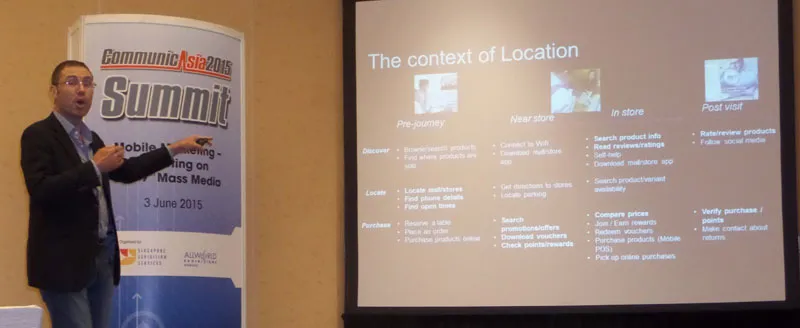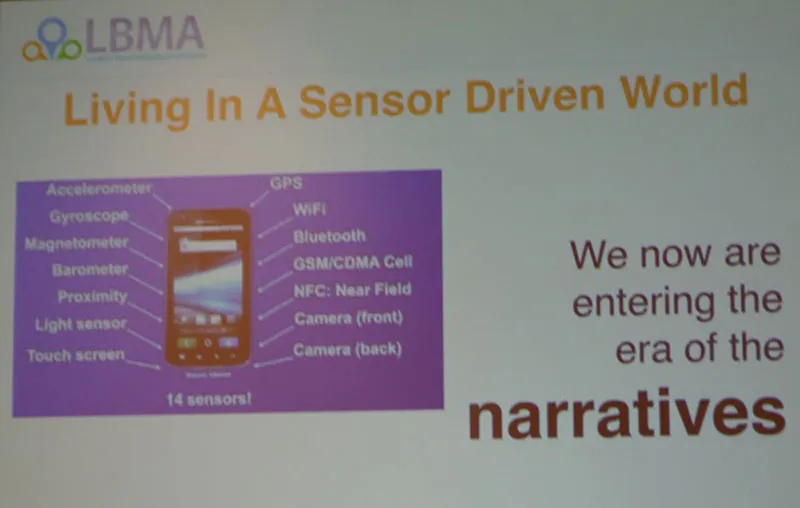Mobile + creativity: 8 innovative examples of location-based marketing
Location-based marketing has come a long way since the basic SMS push-based ads of a decade ago. “Location is the new cookie for the physical world,” explained Asif R. Khan, Founder and President, Location Based Marketing Association (LBMA), speaking at the Communicasia 2015 conference in Singapore.

Via static and mobile objects, marketers now have the chance to tie together places, people and media. A key anchor is the smartphone, which now has upto 14 sensors and is creating new kinds of narratives beyond transactions.
“Location-based marketing is a hot breeding ground for a range of startups in data science,” said Christian Geissendoerfer, CEO, Yoose. Magnetic sensing of the presence of smartphones is being used in new ways for tracking footfalls in venues like malls as well. (See also my coverage of startups at the Mobile Marketing Association’s annual summits here.)
Mobile marketing is such a compelling proposition that Coca Cola has stopped print media advertising in Singapore, said Rannajoy Roy, former ASEAN Digital Marketing Lead at Coca-Cola. “Consumers are like frivolous cats who have to be herded by brands, who are the loyal dogs,” joked Roy, referring to the way brands have to go out of their way to stay relevant in consumers’ digital lives.
“It is no longer sufficient for businesses to be 24X7 responsive to customer needs – they need to anticipate their needs in pre-journey, proximate, in-location and post-visit phases,” said Michael Gethen, Founder and Managing Director, Sprooki.
The speakers presented eight innovative examples of location-based marketing, which open the door to new insights for advertising agencies, marketers, brands, media and startups.

- In Brazil, Nivea used a Bluetooth proximity beacon embedded in magazine ads, which parents could tear out from the page in the form of a wrist-band for their children. A smartphone app can be used to track how far the children walk away from their parents in places like beaches. Parents receive an alert when the child walks out of a pre-defined range, and can then bring them back to safety. Nivea is now seen as not just the maker of creams to be used in sunny locations, but as a brand which cares for its consumers’ children.
- A Moscow newspaper won a Cannes Lion Award for its mobile app ‘Parking Douche,’ which lets users take pictures of poorly-parked cars, eg. in the middle of the footpath or garage entrance. IP tracking is used to ‘shame’ the owners by displaying their license plates on obtrusive web ads and social media viewed in nearby areas.
- US music group BlueBrain has produced the world’s first ‘location aware music album,’ which changes the mood of the music as the app user walks by landmarks in locations like New York city’s Central Park.
- Women's Aid, the UK NGO working to end domestic violence, teamed up with ad agency WCSR to raise awareness about domestic violence via digital out-of-home (DOOH) ads in London. The interactive ad depicted a woman with bruises on her face; through facial recognition technology to track how many passers-by look at the ad and for how long, the bruises disappear as more and more people watch the ad. The campaign’s message is ‘Don’t turn a blind eye to domestic violence,’ and is powered by Weve, a provider of permission-based mobile marketing and commerce services.
- 313 Somerset, a mall near the Somerset MRT station, is Singapore’s first mall to launch a beacon-based mobile advertising network. With their prior permission, users of the Tring313 app can get coupons and sales alerts as soon as they enter 50-500 metre distances from the mall. In many cases, retailers reported 46% sales conversion due to the app.
- Also powered by mobile marketing services firm Sprooki, Stores Specialists Inc. (the Philippines’ largest franchiser of lifestyle brands) launched the first location-aware smartphone application for luxury brand shoppers in the Philippines. The SSI Life app offers limited, time-based promotions such as extra gifts with large purchases in 500 stores as shoppers approach them.
- German pet food company Granata Pet developed a kiosk called Snack Ball Machine which was installed in parks in a number of cities. Each ball has a beacon sensor in it, and the ball is thrown by the vending machine into the park. Dogs which bring the ball back fast enough (based on tracking the distance traveled) are deemed healthy and a bowl of dog food is dispensed from the kiosk.
- Across a number of countries, Coca Cola has innovatively used its vending machines for effective location-aware marketing. Consumers of Japanese tea can get maps of nearby vending machines which stock their favourite cans; the company is also using beacon technology for a range of smart vending machines in countries like Australia. Coca Cola uses the services of Ground Signal, a location-based social media search firm.
These are just some examples of the rise of mobile marketing in Asia and elsewhere. Mobile marketing has emerged as a hot trend in many parts of Asia, thanks to intense engagement with smartphones.
For example, according to research firm Millward Brown, Indonesians use their digital gadgets more than anyone else in the world, and have the highest level of active screen time of any nation on the planet: they consume a daily average of nine hours of total screen media! To keep up with this trend, Indonesian operator Telkomsel has released creative music videos to showcase the power of its LTE 4G network, along with a host of content consumption packages.
Other resources cited at the panel were the new book, ‘The Mobile Mind Shift: Engineer your business to win in the mobile moment’ by Ted Schadler, Josh Bernoff and Julie Ask of Forrester Research.
Much has been said about social listening on Facebook and Twitter – it is also important for brands to do ‘location listening.’ Location-aware marketing has certainly come a long way since its depiction in the John Anderton (Tom Cruise) ads in the sci-fi classic ‘Minority Report!’
“Take your brand to the people, don’t just think about retail stores,” summed up Asif Khan of LBMA.







